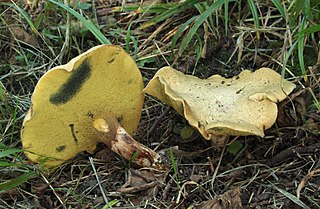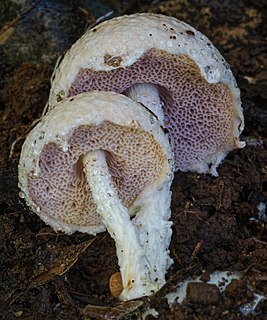
The fungal order Agaricales, also known as gilled mushrooms or euagarics, contains some of the most familiar types of mushrooms. The order has 33 extant families, 413 genera, and over 13,000 described species, along with six extinct genera known only from the fossil record. They range from the ubiquitous common mushroom to the deadly destroying angel and the hallucinogenic fly agaric to the bioluminescent jack-o-lantern mushroom.

The Boletales are an order of Agaricomycetes containing over 1300 species with a diverse array of fruiting body types. The boletes are the best known members of this group, and until recently, the Boletales were thought to only contain boletes. The Boletales are now known to contain distinct groups of agarics, gasteromycetes, and other fruiting-body types.

The Boletaceae are a family of mushroom-forming fungi, primarily characterised by small pores on the spore-bearing hymenial surface, instead of gills as are found in most agarics. Nearly as widely distributed as the agarics, the family is renowned for hosting some prime edible species highly sought after by mushroom hunters worldwide, such as the cep or king bolete . A number of rare or threatened species are also present in the family, that have become the focus of increasing conservation concerns. As a whole, the typical members of the family are commonly known as boletes.

Boletus is a genus of mushroom-producing fungi, comprising over 100 species. The genus Boletus was originally broadly defined and described by Carl Linnaeus in 1753, essentially containing all fungi with hymenial pores instead of gills. Since then, other genera have been defined gradually, such as Tylopilus by Petter Adolf Karsten in 1881, and old names such as Leccinum have been resurrected or redefined. Some mushrooms listed in older books as members of the genus have now been placed in separate genera. These include such as Boletus scaber, now Leccinum scabrum, Tylopilus felleus, Chalciporus piperatus and Suillus luteus. Most boletes have been found to be ectomycorrhizal fungi, which mean that they form a mutualistic relationship with the roots system of certain kinds of plants. More recently, Boletus has been found to be massively polyphyletic, with only a small percentage of the over 300 species that have been assigned to Boletus actually belonging there and necessitating the description and resurrection of many more genera.

Paxillus involutus, commonly known as the brown roll-rim, common roll-rim is a basidiomycete fungus that is widely distributed across the Northern Hemisphere. It has been inadvertently introduced to Australia, New Zealand, South Africa, and South America, probably transported in soil with European trees. Various shades of brown in colour, the fruit body grows up to 6 cm high and has a funnel-shaped cap up to 12 cm wide with a distinctive inrolled rim and decurrent gills that may be pore-like close to the stipe. Although it has gills, it is more closely related to the pored boletes than to typical gilled mushrooms. It was first described by Pierre Bulliard in 1785, and was given its current binomial name by Elias Magnus Fries in 1838. Genetic testing suggests that Paxillus involutus may be a species complex rather than a single species.

Hygrophoropsis aurantiaca, commonly known as the false chanterelle, is a species of fungus in the family Hygrophoropsidaceae. It is found across several continents, growing in woodland and heathland, and sometimes on woodchips used in gardening and landscaping. Fruit bodies (mushrooms) are yellow–orange, with a funnel-shaped cap up to 8 cm across that has a felt-like surface. The thin, often forked gills on the underside of the cap run partway down the length of the otherwise smooth stipe. Reports on the mushroom's edibility vary – it is considered poisonous, but has historically been eaten internationally.

Suillellus luridus, commonly known as the lurid bolete, is a fungus of the family Boletaceae, found in calcareous broadleaved woodlands in Europe. Fruit bodies appear in summer and autumn and may be locally abundant. It is a firm bolete with an olive-brown cap up to 20 cm (8 in) in diameter, with small orange or red pores on the underside. The stout ochre stem reaches 8–14 cm (3–6 in) high and 1–3 cm (0.4–1.2 in) wide, and is patterned with a red network. Like several other red-pored boletes, it stains blue when bruised or cut.

René Charles Joseph Ernest Maire was a French botanist and mycologist. His major work was the Flore de l'Afrique du Nord in 16 volumes published posthumously in 1953. He collected plants from Algeria, Morocco, France, and Mali for the herbarium of the National Botanic Garden of Belgium.

Hortiboletus rubellus, commonly known as the ruby bolete, is a small, dainty, brightly coloured member of the family Boletaceae, with a reddish cap and stipe, and yellow pores. Like many boletes, it stains blue when cut or bruised. It is found in deciduous woodland in autumn. There is some question over its edibility, and it is reportedly of poor quality with a taste of soap. Until 2015, the species was known as Boletus rubellus.

Gyrodon lividus, commonly known as the alder bolete, is a pored mushroom bearing close affinity to the genus Paxillus. Although found predominantly in Europe, where it grows in a mycorrhizal association with alder, it has also recorded from China, Japan and California. Fruit bodies are distinguished from other boletes by decurrent bright yellow pores that turn blue-grey on bruising. G. lividus mushrooms are edible.

Gyrodon is a genus of pored mushroom bearing close affinity to the genus Paxillus. Recent molecular research has confirmed this relationship of the two genera as sister taxa, together diverging as one of the most basal lineages in the Boletineae, and sister to the Boletaceae.

Xerocomus subtomentosus, commonly known as suede bolete, brown and yellow bolet, boring brown bolete or yellow-cracked bolete, is a species of bolete fungus in the family Boletaceae. The fungus was initially described by Carl Linnaeus in 1753 and known for many years as Boletus subtomentosus. It is edible, though not as highly regarded as other bolete mushrooms.

Austroboletus is a genus of fungi in the family Boletaceae. The widely distributed genus contains 28 species that form mycorrhizal relationships with plants.

Chalciporus is a genus of fungi in the family Boletaceae. There are approximately 25 species in the genus.

Bothia is a fungal genus in the family Boletaceae. A monotypic genus, it contains the single species Bothia castanella, a bolete mushroom first described scientifically in 1900 from collections made in New Jersey. Found in the eastern United States, Costa Rica, China, and Taiwan, it grows in a mycorrhizal association with oak trees. Its fruit body is chestnut brown, the cap is smooth and dry, and the underside of the cap has radially elongated tubes. The spore deposit is yellow-brown. The edibility of the mushroom is unknown. Historically, its unique combination of morphological features resulted in the transfer of B. castanella to six different Boletaceae genera. Molecular phylogenetic analysis, published in 2007, demonstrated that the species was genetically unique enough to warrant placement in its own genus.

Hygrophoropsis is a genus of gilled fungi in the family Hygrophoropsidaceae. It was circumscribed in 1888 to contain the type species, H. aurantiaca, a widespread fungus that, based on its appearance, has been affiliated with Cantharellus, Clitocybe, and Paxillus. Modern molecular phylogenetic analysis shows that the genus belongs to the suborder Coniophorineae of the order Boletales.

Rubroboletus rhodoxanthus is a species of bolete in the family Boletaceae, native to Europe. Previously known as Boletus rhodoxanthus, it was transferred in 2014 to the newly erected genus Rubroboletus, based on DNA data.

Austropaxillus is a genus of fungi in the family Serpulaceae, containing nine species found in Australia, New Zealand and South America.

Boletinellus merulioides, commonly known as the ash-tree bolete, is a species of bolete fungus in the family Boletinellaceae. Described as new to science in 1832, it is found in Asia and eastern North America, where it grows on the ground near ash trees.

Buchwaldoboletus lignicola is a species of bolete fungus in the family Boletaceae native to Europe and North America. Found on wood, it is actually parasitic on the fungus Phaeolus schweinitzii. It has a convex yellow- to rusty brown cap, yellow to yellow-brown pores and stipe, and a brown spore print. Its edibility is unknown.




















